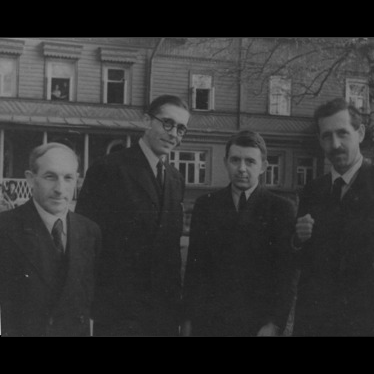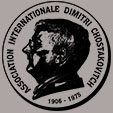Catégorie : Non classé
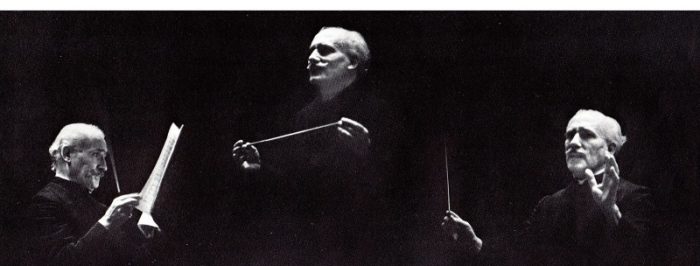
Arturo Toscanini – Philadelphia Orchestra
Schubert Symphony n°9 D.944
Academy of Music – November 16, 1941
Prod: Charles O’Connell – Eng: Fred Lynch
Source: 33t/LP RCA Album 5LP RL 01900(5)

Les problèmes techniques qu’ont connus ces enregistrements au cours des étapes techniques jusqu’à l’obtention des épreuves 78 tours sont bien connus, notamment du livre de Charles O’Connell, ‘The Other Side of the Record’, du texte de David Hall qui accompagne le coffret RL 01900(5) de 1976 consacré à la première publication de l’ensemble des enregistrements de Toscanini à Philadelphie et de l’article consacré à ce coffret par Harris Goldsmith et paru en janvier 1977 (High Fidelity).
Qu’il ait été possible d’obtenir un résultat final apte à restituer le génie de ces interprétations tient, nous dit-on, presque du miracle.
Selon Harris Goldsmith (High Fidelity, janvier 1977 pages 103-105) : ‘La collaboration avec Toscanini fonctionne peut-être le mieux dans la symphonie de Schubert. Cette interprétation – richement lyrique, souple dans le tempo, dramatique à couper le souffle (très différente des deux enregistrements ultérieurs avec le NBC Symphony) – est tout simplement la meilleure que j’aie jamais entendue’.
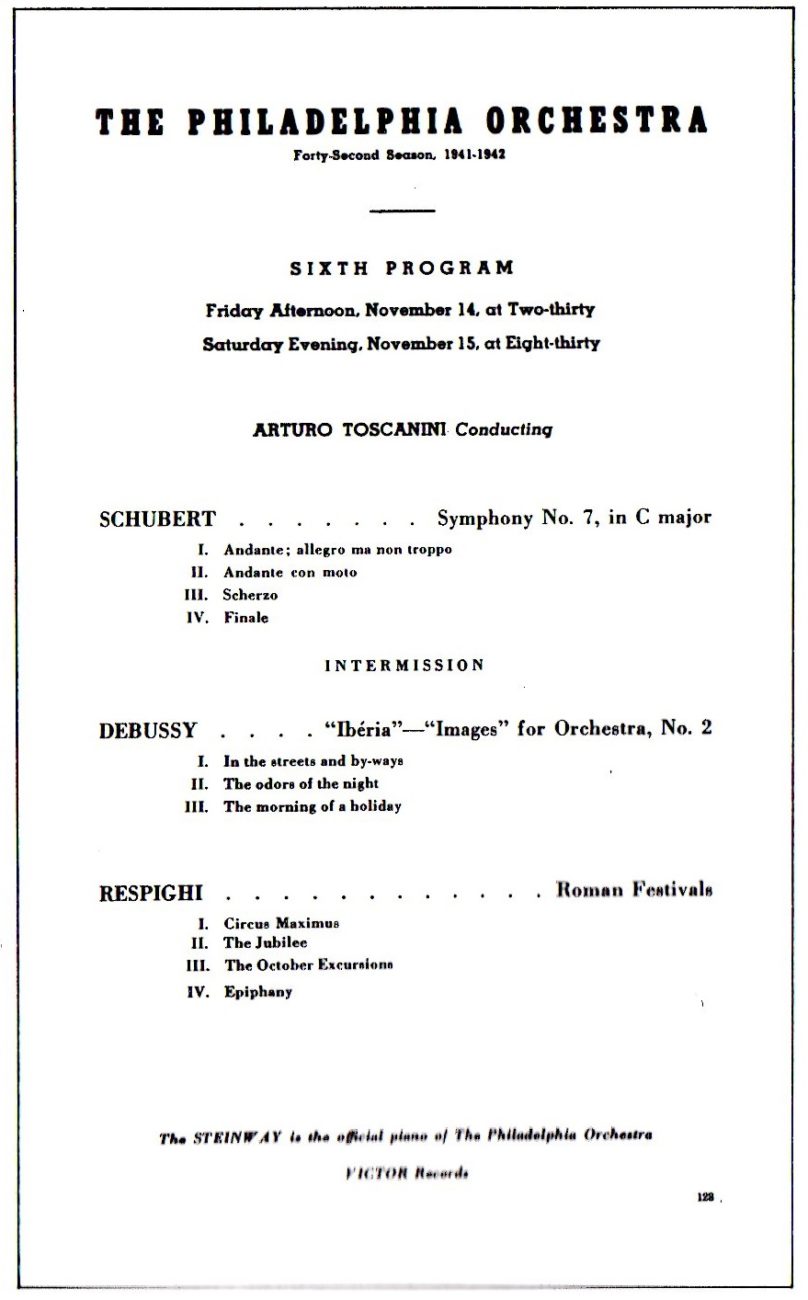
Schubert: Séance d’enregistrement / Recording Session (Academy of Music)
Cliquer sur l’image pour l’agrandir / Click on the picture to enlarge
The technical problems that these recordings experienced during the technical stages until the 78 rpm test pressings were obtained are well known, especially from Charles O’Connell’s book, ‘The Other Side of the Record’, from the text by David Hall that accompanies the 1976 boxed set RL 01900(5) devoted to the first publication of all of the Toscanini’s recordings in Philadelphia, and from the article dedicated to this box set by Harris Goldsmith and published in January 1977 (High Fidelity).
That it was possible to obtain a final result able to restore the genius of these interpretations is, as we are told, almost a miracle.
According to Harris Goldsmith (High Fidelity January 1977 pages 103-105): ‘The collaboration with Toscanini perhaps works best in the Schubert symphony. This performance – richly lyrical, flexible in tempo, hairraisingly dramatic (quite different from the two later recordings with the NBC Symphony)- is simply the greatest I have ever heard.’
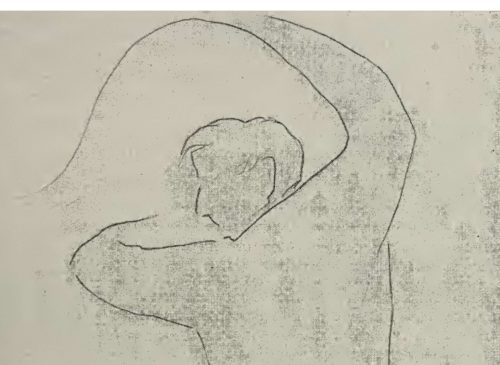
Charles Munch BSO
Berlioz Benvenuto Cellini, Ouverture Op.23
Debussy: Images n°2 Ibéria (Par les rues et par les chemins – Les parfums de la nuit – Le matin d’un jour de fête)
Ravel: Daphnis et Chloé Suite n°2 (Lever du jour – Pantomime – Danse Générale)
Boston Symphony Hall – February 12, 1965
Source: Bande/Tape 2 pistes 19 cm/s / 2 tracks 7.5 ips
Charles Munch a été le Directeur Musical du Boston Symphony Orchestra (BSO) de 1949 à 1962. Après sa démission, il est revenu chaque saison à Boston comme chef invité, en programmant des essentiellement des œuvres qui étaient au cœur de son répertoire.
C’est le cas pour ce concert de musique française qui comportait également la Quatrième Symphonie d’ Albert Roussel que nous vous avons déjà proposée.
Le présentateur William Pierce nous donne au passage les noms des solistes de l’orchestre que Munch a invités à saluer le public: Hugh Matheny,* hautbois (Berlioz, Debussy), Laurence Thorstenberg*, cor anglais (Debussy) et Doriot Anthony Dwyer, flûte (Ravel).
Munch était dans un grand jour et la prise de son est magnifique. Munchissimo….
* Nouveau membre du BSO à partir de la Saison 1964-1965.
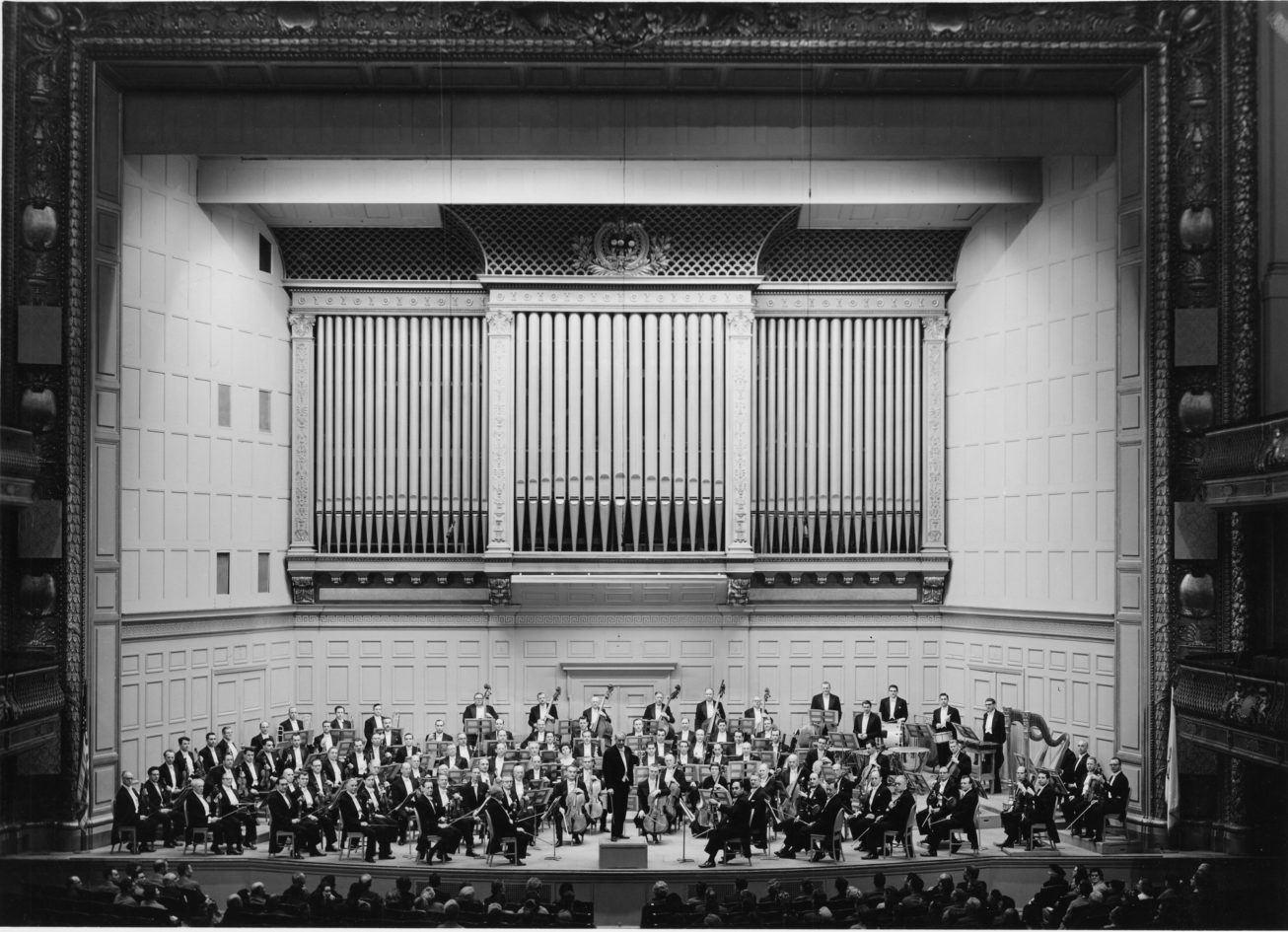
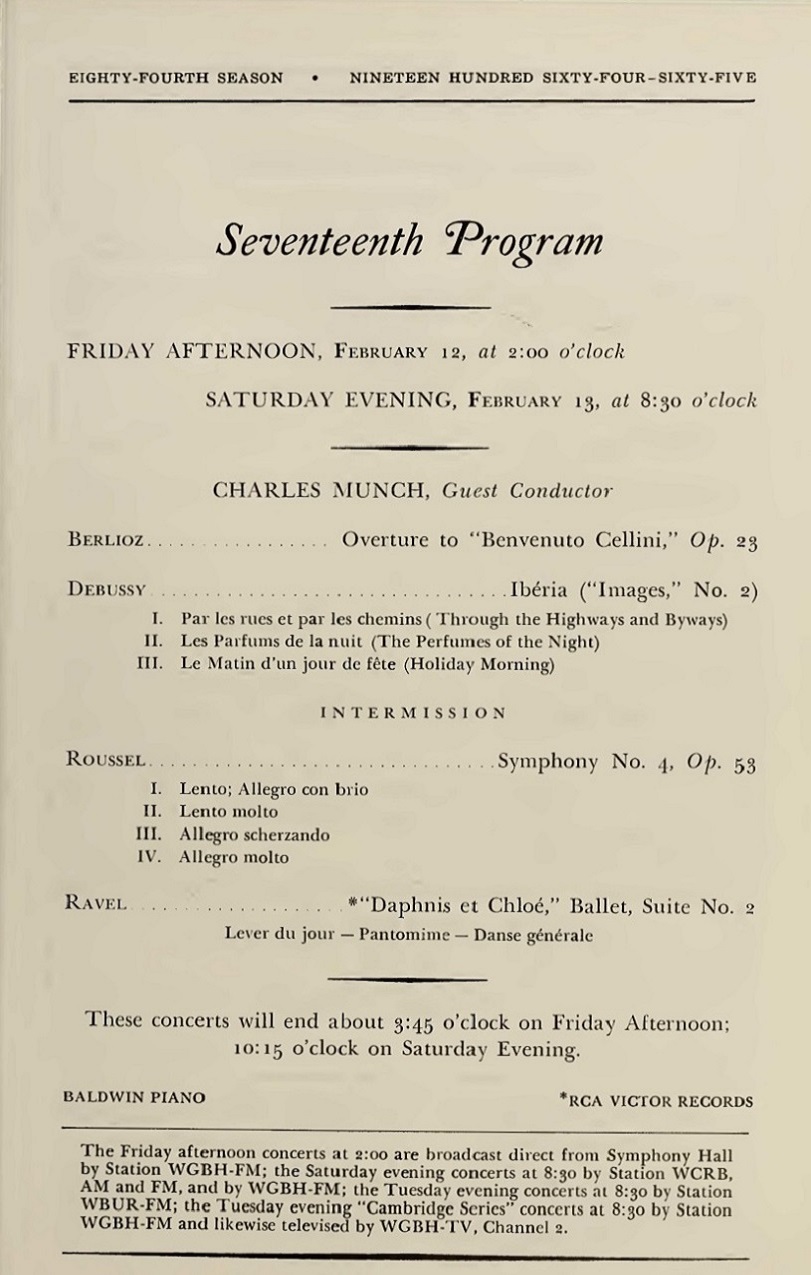
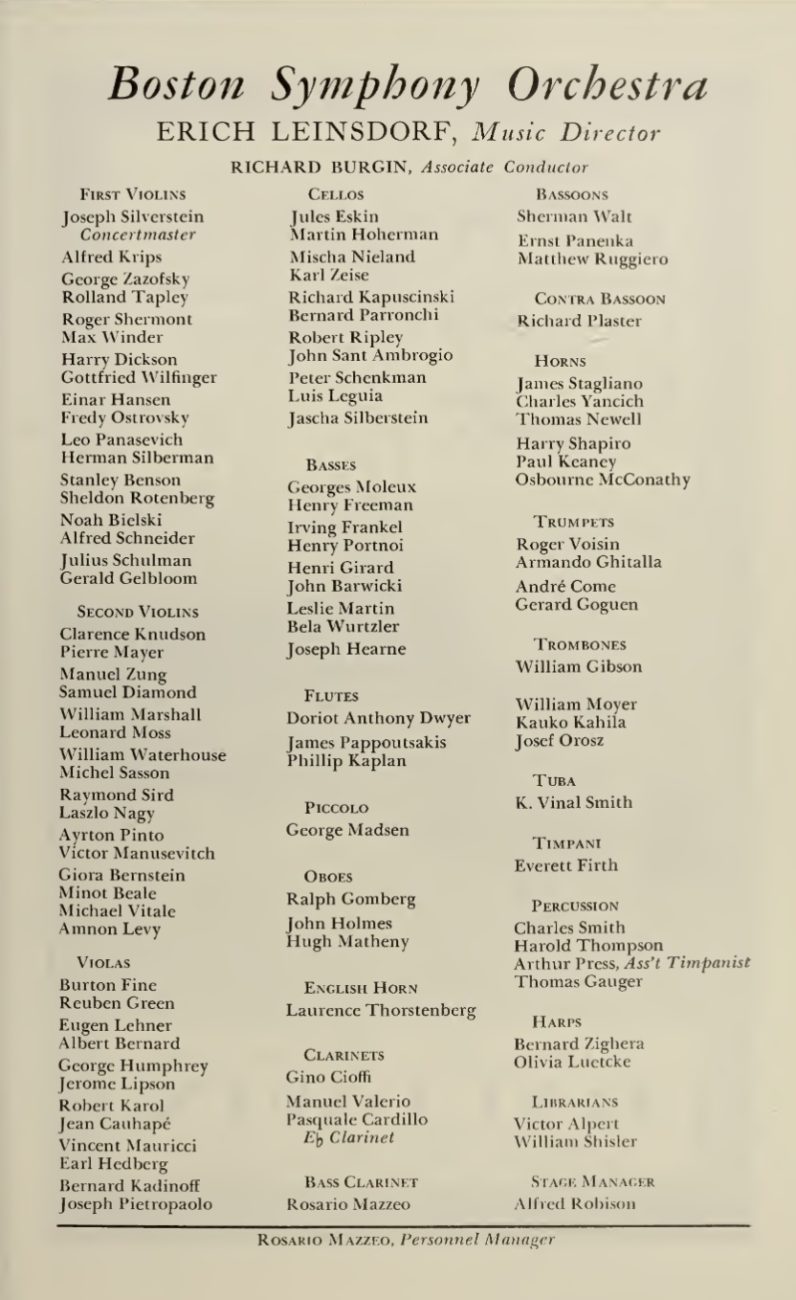
Charles Munch was Music Director of the Boston Symphony Orchestra (BSO) from 1949 to 1962. After his resignation, he returned each season to Boston as a guest conductor, programming primarily works that were central to his repertoire.
This was the case for this concert of French music, which also included Albert Roussel’s Fourth Symphony, which we have previously featured.
Presenter William Pierce gives us the names of the orchestra soloists that Munch invited to acknowledge the applause: Hugh Matheny*, oboe (Berlioz, Debussy), Laurence Thorstenberg*, English horn (Debussy) and Doriot Anthony Dwyer, flute (Ravel).
Munch was on a great day and the sound recording is magnificent. Munchissimo….
* New member of the BSO from the 1964-1965 Season.
Arturo Toscanini NBC SO
Brahms Symphony n°4 Op.98
Carnegie Hall – December 22, 1951
Prod: Don Gillis – Eng: George Mathes
Source: Bande / Tape – 38 cm/s / 15 ips
La ‘Quatrième’ de Brahms a toujours réussi à Arturo Toscanini, comme le prouvent les nombreux enregistrements dont on dispose entre les concerts des 3 & 5 mai 1935 au Queen’s Hall de Londres avec le BBC SO et celui du 1er Octobre 1952 au Royal Festival Hall de Londres avec le Philharmonia Orchestra.
Entre temps, nous avons pas moins de six interprétations captées en concert avec le NBC SO (11 février 1939, 10 Janvier 1943, 28 Octobre 1945, 27 Novembre 1948, 26 février 1950 et enfin 22 Décembre 1951 lors d’un concert au profit de l’ ‘Italian Welfare League’), mais aussi un enregistrement fait à Carnegie Hall pour RCA le 3 Décembre 1951*, c’est-à-dire la version ‘officielle’ que connaissent les mélomanes.
Si la préférence des critiques va au concert de 1948 (réédité dans l’Album de 2CD EMI ‘Great Conductors of the 20th Century’ Ref: 7243 5 62939 2 2), il n’en est pas moins vrai que la version inédite du 22 décembre 1951 possède des vertus propres tout à fait convaincantes.
En effet, elle surclasse nettement la version en studio réalisée trois semaines auparavant.
Comme c’est souvent le cas avec Toscanini, l’enregistrement de concert s’avère beaucoup plus libre dans les phrasés avec ici de très beaux passages cantabile, dans la rythmique qui respire plus, ainsi que dans la conduite du discours musical, plus variée. L’inspiration est au rendez-vous!
D’autre part, la prise de son en public à Carnegie Hall (due à George Mathes) est d’un naturel tout à fait remarquable.
*En fait, cette symphonie a été jouée six fois au cours de la tournée de 1950 du NBC SO (14 avril-27 mai), et Toscanini voulait qu’elle fasse partie des enregistrements réalisés début juin, mais ce projet a été annulé au profit de l ‘Ibéria’ de Debussy.
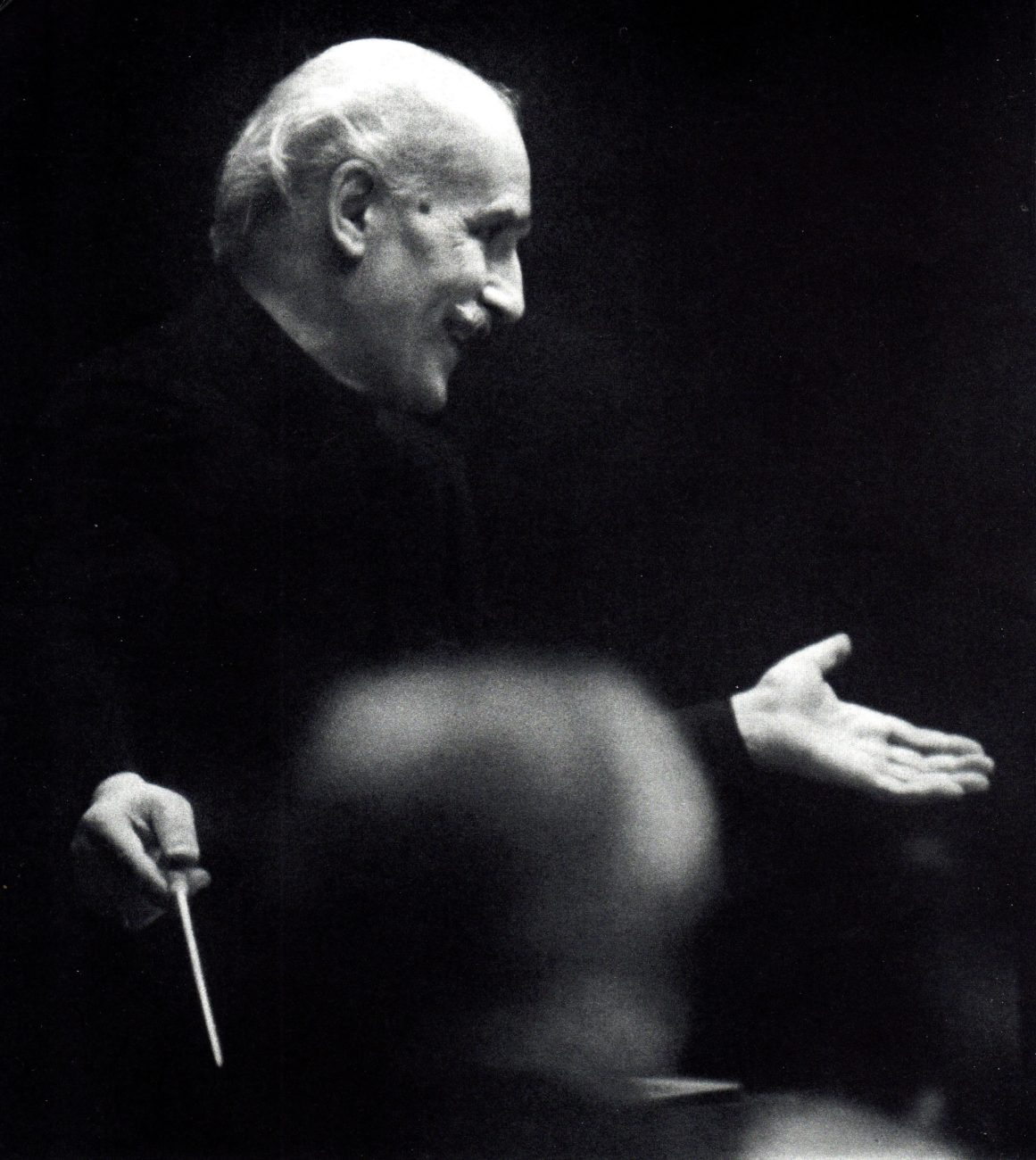
The Brahms ‘Fourth’ has always been a success for Arturo Toscanini, as evidenced by the many recordings available between the concerts of 3 & 5 May 1935 at Queen’s Hall in London with the BBC Symphony Orchestra and the concert of 1 October 1952 at the Royal Festival Hall in London with the Philharmonia Orchestra.
In between, we have no less than six performances recorded in concert with the NBC SO (11 February 1939, 10 January 1943, 28 October 1945, 27 November 1948, 26 February 1950 and finally 22 December 1951 at a concert in aid of the Italian Welfare League) but also a recording made at Carnegie Hall for RCA on 3 December 1951*, i.e. the ‘official’ version known to music lovers.
Although critics rather prefer the 1948 concert (reissued in the EMI 2CD album ‘Great Conductors of the 20th Century’ Ref: 7243 5 62939 2 2), it is nevertheless true that the previously unpublished version of 22 December 1951 has its own convincing virtues.
Indeed, it clearly outperforms the studio version made three weeks earlier.
As is often the case with Toscanini, the concert recording proves to be much freer in the phrasings, here with some very beautiful cantabile passages, in the rhythmic pattern, which breathes more, and in the conduct of the musical discourse, which is more varied. The inspiration is here!
On the other hand, the live recording at Carnegie Hall (by George Mathes) is remarkably natural.
*In fact, this symphony was played six times during the NBC SO 1950 tour (14 April-27 May), and Toscanini wanted it to be included in the recordings made in early June, but this project was cancelled in favour of Debussy’s ‘Ibéria’.

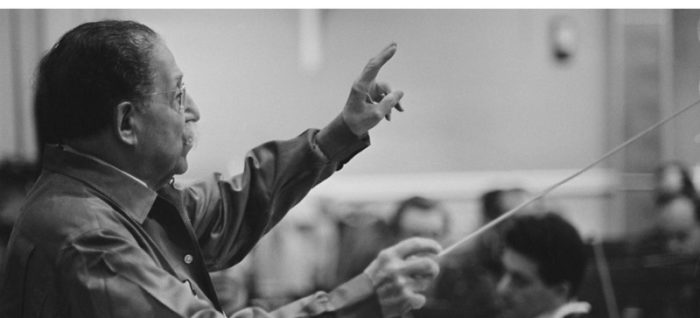
Pierre Monteux – London Symphony Orchestra (LSO)
Debussy: Prélude à l’Après-midi d’un faune – 2 Nocturnes Nuages & Fêtes
Ravel: Rapsodie Espagnole – Pavane pour une Infante défunte
London Kingsway Hall 11-13 December 1961
Prod: Erik Smith – Eng: Kenneth Wilkinson
Source: Bande/Tape: LCL 80108 (4 pistes 19 cm/s / 4 tracks 7.5 ips)
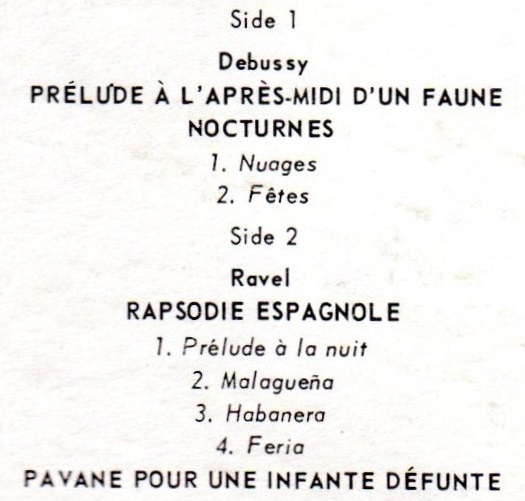

Le programme choisi par Monteux peut surprendre, mais il montre une subtile correspondance entre les deux compositeurs, les œuvres de chacun d’entre eux alternant d’une part poésie et gravité et d’autre part chaleur, énergie et brillant.
Dans le numéro de Janvier 1963 de ‘High Fidelity’, le critique a tout particulièrement souligné le caractère exceptionnel des interprétations du Prélude à l’Après-Midi d’un faune pour lequel le naturel de l’interprétation loin de tout sentimentalisme impressionniste fait l’effet d’une révélation ainsi que de la Pavane pour une Infante défunte pour sa plasticité et sa chaleur.
A propos de la Rapsodie Espagnole, le critique a souligné la chaleur et la profondeur de la prise de son à Kingsway Hall qui restitue admirablement ce qu’il appelle le ‘rougeoiement’ (‘ruddy glow’) de la palette sonore de l’orchestre.
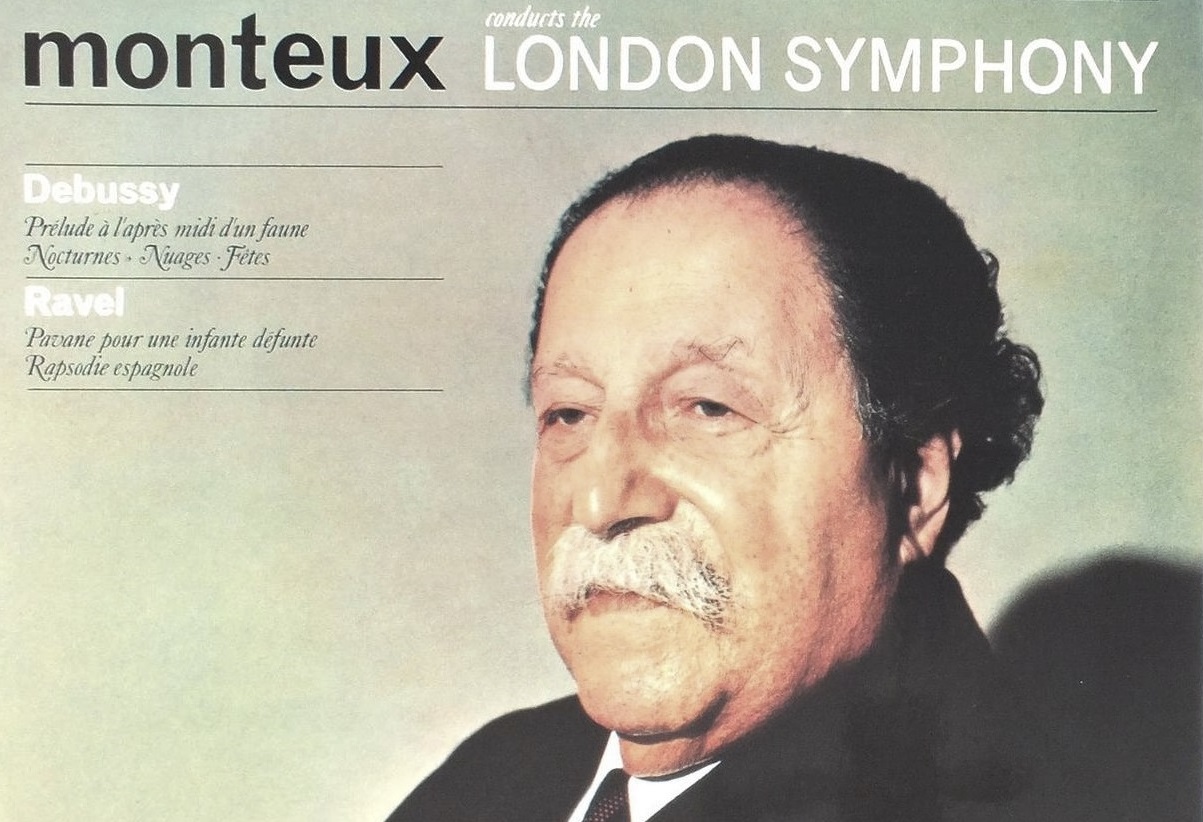
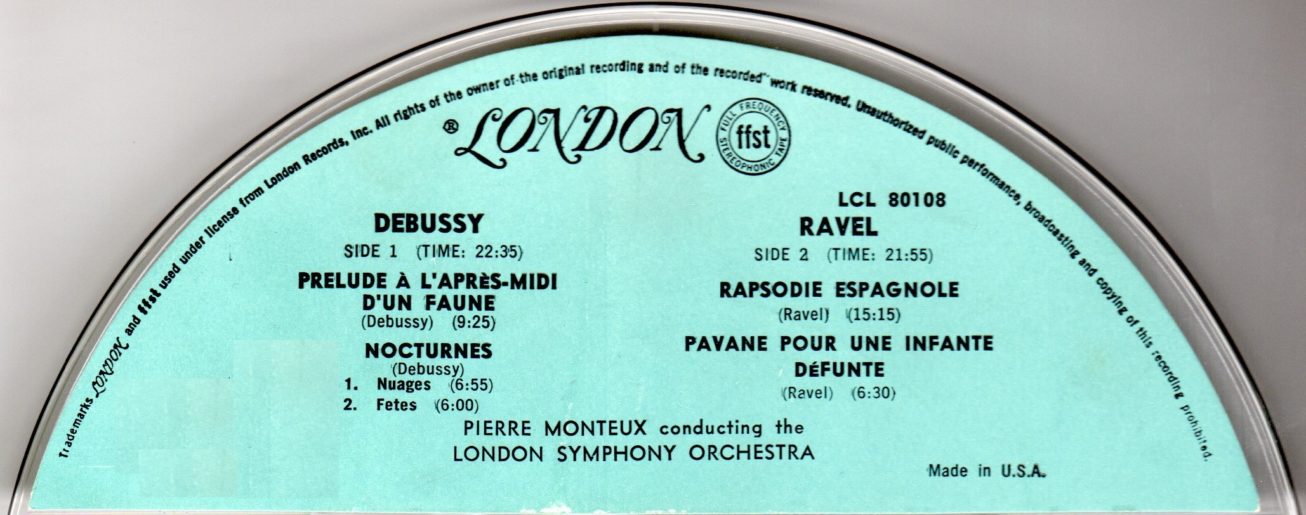
The programme chosen by Monteux may be surprising, but it shows a subtle correspondence between the two composers, the works of each of them alternating on the one hand poetry and gravity and on the other warmth, energy and brilliance.
In the January 1963 issue of High Fidelity, the critic particularly emphasised the exceptional character of the performances of the Prélude à l’Après-Midi d’un faune, for which the naturalness of the interpretation, far from any impressionist sentimentality, is a revelation, and of the Pavane pour une Infante défunte for its plasticity and warmth.
In the Rapsodie Espagnole, the critic emphasised the warmth and depth of the Kingsway Hall recording, which admirably renders what he calls the ‘ruddy glow’ of the orchestra.
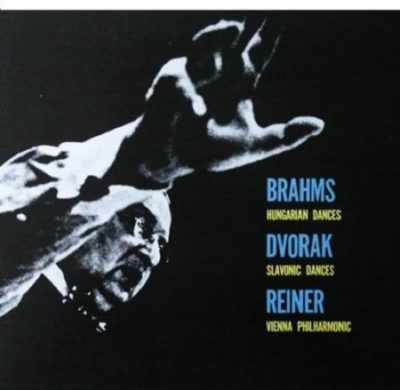
Fritz Reiner Wiener Philharmoniker (WPO)
Dvořák Slavonic Dances Op.46 n°1, 3 & 8; Op.72 n° 2 & 1
Brahms Hungarian Dances n° 5, 6, 7, 12, 13, 19, 21 & 1
Enr/Rec: Wien Sofiensaal 12, 13, 16 & 19 Juni 1960
Prod: Erik Smith – Eng: James Brown
Source: Bande /Tape: LCL-80069 (4 pistes 19 cm/s / 4 tracks 7.5 ips)

En 1960, Fritz Reiner, dans le cadre des accords entre les firmes RCA et Decca, est venu à Vienne sans donner de concert ni diriger à l’Opéra, mais seulement pour enregistrer le Requiem de Verdi, ainsi que ce disque de danses de Brahms et de Dvořák, dans lequel il se montre un maître incomparable avec une subtilité rythmique vraiment fascinante.
L’étude de la période du 12 au 19 juin 1960 montre que le plan de charge de l’orchestre (comme montré ci-dessous) était incroyablement chargé, mais fort heureusement, cela n’a pas affecté la qualité des exécutions de ces danses.
Le terme WPO désigne on le sait la formation de concert de l’Orchestre du Wiener Staatsoper dont l’effectif important permet d’assurer plusieurs prestations simultanées (Opéra, Ballets, enregistrements).
Concernant les enregistrements, Reiner a complété les 12, 13, 16, 19 & 26 juin le Requiem de Verdi commencé en mai, et entre le 12 et le 20 Herbert von Karajan a enregistré une intégrale du Fledermaus de Johann Strauss.
Pour les concerts: les 18 et 19 juin, Mahler Das Lied von der Erde sous la direction de Karajan avec Fritz Wunderlich et Hilde Rössel-Majdan.
Pour l’Opéra: le 12 et le 14 Götterdämmerung (Karajan); le 13 Aïda (Molinari-Pradelli); le 15 et le 17 Arabella (Keilberth le 15 et Hollreiser le 17); le 16 Ballo in Maschera (Molinari-Pradelli); le 18 Entführung aus dem Serail (Krips à la Redoutensaal) / Carmen (Matacic).
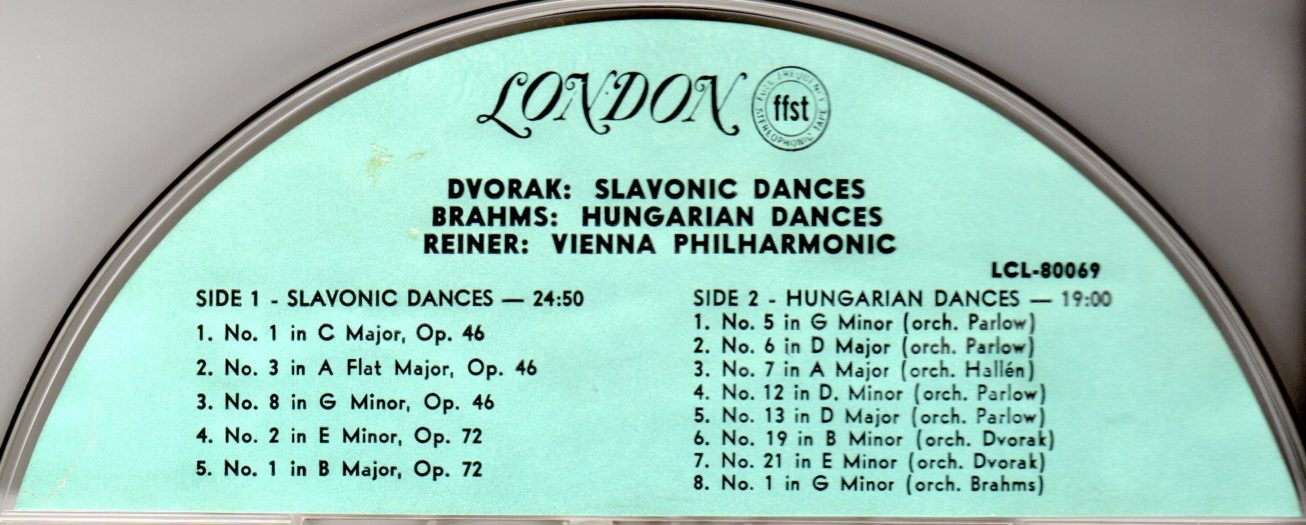
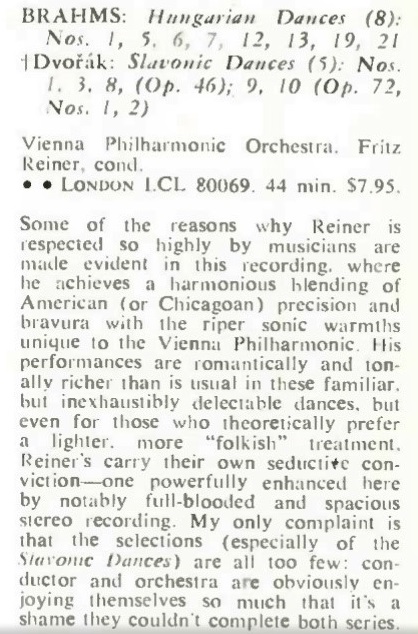
High Fidelity (July 1961)
In 1960 Fritz Reiner, as part of the agreements between RCA and Decca, came to Vienna without giving a concert or conducting at the Opera, but only to record Verdi’s Requiem and this disc of dances by Brahms and Dvořák, in which he shows himself to be an incomparable master with a truly fascinating rhythmic subtlety.
A study of the period from 12 to 19 June 1960 shows that the workload of the orchestra (as shown below) was incredibly heavy, but fortunately this did not affect the quality of the recorded performances of these dances.
The term WPO refers to the concert orchestra of the Vienna State Opera Orchestra, whose large number of members makes it possible to give several performances at the same time (opera, ballets, recordings).
Concerning the recordings, Reiner completed Verdi’s Requiem on 12, 13, 16, 19 & 26 June, which he had begun in May, and between 12 and 20 June Herbert von Karajan recorded the complete Fledermaus by Johann Strauss.
For the concerts: on 18 and 19 June, Mahler’s Das Lied von der Erde under the direction of Karajan with Fritz Wunderlich and Hilde Rössel-Majdan.
For the operas: on June 12 and 14, Götterdämmerung (Karajan); on June 13, Aida (Molinari-Pradelli); on June 15 and 17, Arabella (Keilberth on the 15th and Hollreiser on the 17th); on June 16, Ballo in Maschera (Molinari-Pradelli); on June 18, Entführung aus dem Serail (Krips at the Redoutensaal) / Carmen (Matacic).


